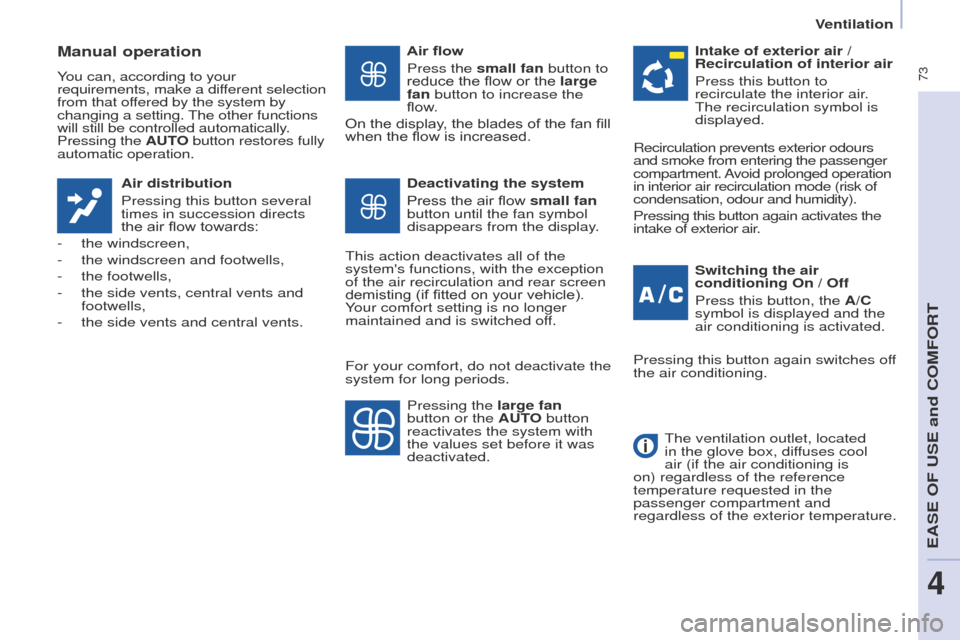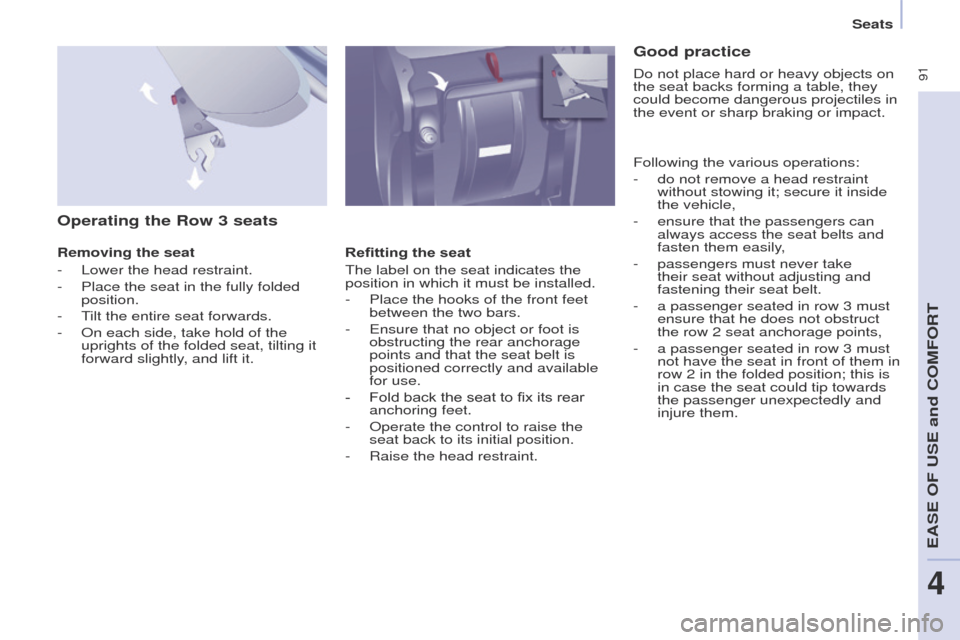2017 Peugeot Partner Tepee tow
[x] Cancel search: towPage 38 of 292

36
Partner2VP_en_Chap03_Pret-a-partir_ed02-2016Partner2VP_en_Chap03_Pret-a-partir_ed02-2016
Warning lamp isindicatesSolution - action
Dipped beam
headlamps
/
Daytime
running
lamps on.a manual selection or
automatic illumination of
headlamps.
Turn the ring on the lighting control stalk to the
second position.
illumination of the dipped beam headlamps
from the time the ignition is switched on:
daytime running lamps (depending on the
country in which the vehicle is sold).
Chapter 4, "Steering mounted controls" section.
Main beam
headlamps pulling of the stalk towards
you.Pull the stalk to return to dipped beam
headlamps.
Direction
indicators flashing with
audible signal.a change of direction via
the lighting stalk. Flashing right: push stalk downwards.
Flashing left: push stalk upwards.
Front
foglamps on.
a manual selection. The foglamps only operate if the sidelamps or
dipped beam headlamps are on.
Rear
foglamps on.
a manual selection. The foglamps only operate if the sidelamps or
dipped beam headlamps are on.
In conditions of normal visibility, switch them off
to avoid breaking the law.
"This lamp is a dazzling red".
Instruments and controls
Page 60 of 292

58
Partner2VP_en_Chap04_Ergonomie_ed02-2016
DIRECTION INDICATORS
"Motorway" function
Press the control up or down to flash
the corresponding direction indicator
three times.
LIGHTING
Left: downwards passing the
point of resistance.
Right: upwards passing the
point of resistance.
Front and rear lighting
Lighting off
Automatic illumination of
headlamps
SidelampsDipped beam (green)
Dipped beam/main beam change
Pull the stalk fully towards you.
Lighting-on audible warning
On switching off the ignition, all of the
lamps turn off, except dipped beam if
automatic guide-me-home lighting has
been activated.
Checking by means of the
indicator lamps in the instrument
panel is described in the
"Instruments and controls" section
of chapter 3.
Direction indicators
Selection is by turning this
ring. Main beam (blue)
To activate the lighting
control, turn this ring to
the lighting off position "0"
then to the selection of
your choice.
On opening the driver's door, there is
an audible warning if you have left the
lighting on.
Steering mounted controls
Page 64 of 292

62
Partner2VP_en_Chap04_Ergonomie_ed02-2016
Screenwash
Pull the stalk towards you, the wash-
wipe is accompanied by a timed sweep
of the wipers.Turn the ring past the first
position: the rear screenwash
then the rear wiper operates
for a fixed time.
In winter, in the event of a
considerable amount of snow
or ice, switch on the heated
rear screen. Once the screen is
clear, remove the snow or ice which
has accumulated on the rear wiper
blade. You can then operate the rear
windscreen wiper.
To top up the level, refer to the
"Levels" section of chapter 7.
Special position of the
windscreen wipers
In the minute following switching
off of the ignition, any action on the
stalk positions the wipers against the
windscreen uprights.
This action enables you to position
the wiper blades for winter parking,
cleaning or replacement.
Refer to the "Changing a windscreen
wiper blade" section of chapter 8.
To park the wipers in their normal
position after this has been done,
switch on the ignition and move
the
stalk. Turn the ring to the first
position.
Rear wiper
Rear screenwash
Steering mounted controls
Page 75 of 292

73
Partner2VP_en_Chap04_Ergonomie_ed02-2016Partner2VP_en_Chap04_Ergonomie_ed02-2016
Manual operation
You can, according to your
requirements, make a different selection
from that offered by the system by
changing a setting. The other functions
will still be controlled automatically.
Pressing the AUTO button restores fully
automatic operation.Air distribution
Pressing this button several
times in succession directs
the air flow towards:
-
the windscreen,
-
the windscreen and footwells,
-
the footwells,
-
the side vents, central vents and
footwells,
-
the side vents and central vents. Air flow
Press the
small fan button to
reduce the flow or the large
fan button to increase the
flow.
On the display, the blades of the fan fill
when the flow is increased.
Switching the air
conditioning On
/ Off
Press this button, the A/C
symbol is displayed and the
air conditioning is activated.
Deactivating the system
Press the air flow small fan
button until the fan symbol
disappears from the display.
This action deactivates all of the
system's functions, with the exception
of the air recirculation and rear screen
demisting (if fitted on your vehicle).
Your comfort setting is no longer
maintained and is switched off. Intake of exterior air
/
Recirculation of interior air
Press this button to
recirculate the interior air.
The recirculation symbol is
displayed.
Pressing the large fan
button or the AUTO button
reactivates the system with
the values set before it was
deactivated. Recirculation prevents exterior odours
and smoke from entering the passenger
compartment. Avoid prolonged operation
in interior air recirculation mode (risk of
condensation, odour and humidity).
Pressing this button again activates the
intake of exterior air.
Pressing this button again switches off
the air conditioning.
The ventilation outlet, located
in the glove box, diffuses cool
air (if the air conditioning is
on) regardless of the reference
temperature requested in the
passenger compartment and
regardless of the exterior temperature.
For your comfort, do not deactivate the
system for long periods.
EASE OF USE and COMFORT
4
Ventilation
Page 78 of 292

76
Partner2VP_en_Chap04_Ergonomie_ed02-2016Partner2VP_en_Chap04_Ergonomie_ed02-2016
DEMISTING AND DEFROSTING
G
OOD PRACTICE
V
ents
"Leave them open"
For optimum distribution and diffusion
of hot or cool air in the passenger
compartment, there are adjustable
central and side vents which can
be directed sideways (right or left)
or vertically (up or down). For your
comfort while driving, do not close
them and direct the flow of air towards
the windows instead.
Air vents in the footwells and directed
towards the windscreen complete the
equipment.
Do not block the vents located at the
windscreen or the air extractor located
in the boot.
Dust filter, odour filter
(activated
carbon)
This filter traps certain dust and limits
odours.
Ensure that this filter is in good
condition and have all of the filter
elements replaced regularly.
Refer to the "Checks" section of
chapter 7.
Air conditioning
In all seasons, the air conditioning
should only be used with the
windows closed. However, if the
interior temperature remains high
after a prolonged period parked in
the sun, first ventilate the passenger
compartment for a few minutes.
Use the AUTO mode as much as
possible as it permits optimised
control of all of the functions: air flow,
passenger compartment comfort
temperature, air distribution, air
intake mode or air recirculation in the
passenger compartment.
Operate the air conditioning system for
5 to 10 minutes, once or twice a month,
to keep it in good working order.
If the system does not produce cold air,
do not use it and contact a PEUGEOT
dealer or a qualified workshop.
Automatic mode: visibility
programme
The comfort programme (AUTO) may
not be sufficient to quickly demist or
defrost the windows (humidity, several
passengers, ice).
In this case, select the visibility
programme. The visibility programme
indicator comes on.
It activates the air conditioning, the air
flow and provides optimum distribution
of the ventilation to the windscreen and
side windows.
It deactivates the air recirculation. It is normal that the condensation
created by the air conditioning system
results in a flow of water which may
form a puddle under the vehicle when
parked.
Ventilation
Page 91 of 292

89
Partner2VP_en_Chap04_Ergonomie_ed02-2016Partner2VP_en_Chap04_Ergonomie_ed02-2016
Entering, exiting from Row 3
Entering
-
Place the row 2 seat in the table
position.
Exiting
-
Lower the head restraint fully
.
-
Operate the yellow control, located
on the back of the row 2 seat
backrest.
-
Fold the seat backrest to the table
position. Ensure that the centre seat belt is
stowed correctly in its housing in
the headlining.
-
T
ilt it to the fully folded position to
allow access. -
Pull the red strap to place the seat
in the fully folded position.
-
T ilt the entire seat forwards.
-
Exit via the side door
.
Before folding it back, ensure that
the feet of the passenger in row 3
are not obstructing the row 2 seat
anchoring points.
EASE OF USE and COMFORT
4
Seats
Page 93 of 292

91
Partner2VP_en_Chap04_Ergonomie_ed02-2016Partner2VP_en_Chap04_Ergonomie_ed02-2016
Operating the Row 3 seats
Removing the seat
-
Lower the head restraint.
-
Place the seat in the fully folded
position.
-
T
ilt the entire seat forwards.
-
On each side, take hold of the
uprights of the folded seat, tilting it
forward slightly
, and lift it. Refitting the seat
The label on the seat indicates the
position in which it must be installed.
-
Place the hooks of the front feet
between the two bars.
-
Ensure that no object or foot is
obstructing the rear anchorage
points and that the seat belt is
positioned correctly and available
for use.
-
Fold back the seat to fix its rear
anchoring feet.
-
Operate the control to raise the
seat back to its initial position.
-
Raise the head restraint.
Good practice
Following the various operations:
-
do not remove a head restraint
without stowing it; secure it inside
the vehicle,
-
ensure that the passengers can
always access the seat belts and
fasten them easily
,
-
passengers must never take
their seat without adjusting and
fastening their seat belt.
-
a passenger seated in row 3 must
ensure that he does not obstruct
the row 2 seat anchorage points,
-
a passenger seated in row 3 must
not have the seat in front of them in
row 2 in the folded position; this is
in case the seat could tip towards
the passenger unexpectedly and
injure them.
Do not place hard or heavy objects on
the seat backs forming a table, they
could become dangerous projectiles in
the event or sharp braking or impact.
EASE OF USE and COMFORT
4
Seats
Page 103 of 292

101
Partner2VP_en_Chap04_Ergonomie_ed02-2016Partner2VP_en_Chap04_Ergonomie_ed02-2016
ZENITH ROOF BARS
The maximum authorised weight on
each roof bar is 35 kg.In all cases, the load must rest on
the non-slip bands provided for this
purpose and must not touch the roof or
the glazing of the roof.
Recommendations for loading the
roof
This procedure requires the use of
a spanner supplied with the tools for
changing a wheel.
These two longitudinal Zenith roof bars
can be removed.
Chapter 9, "Changing a wheel"
section.
-
Open the protective covers.
-
Slacken the four screws using the
spanner and remove them.
-
T
urn the bars 90° placing the
hollow parts towards the front.
-
Refit the the 4 screws and tighten
them using the spanner
.
-
Close the protective covers.
-
Use the strap passages
A only to
secure the load firmly.
EASE OF USE and COMFORT
4
Practical information